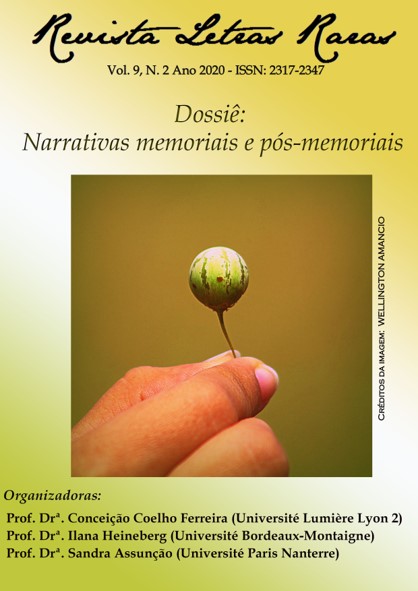Memory and Space of the city of Manaus in the chronicle ‘Dried margins of the city’ (2013), by Milton Hatoum
Keywords:
Espaço, Memória, Manaus, Milton HatoumAbstract
The Brazilian Amazônia, North region of the country, specifically, Manaus city, provided great part of the literary
production of Milton Hatoum. An example are the works: Tale of a certain Orient (1989), The brothers (2000), Ashes
of the Amazon (2005) and A lonely lurking (2013), in which we understand Manaus city as a constructed space and
evoked several times by the memorialist discourse of the author. In this way, we aim to discuss the evolution of
Manaus city space, from the relation among the memories constructed in childhood and the return to the same
spaces in adulthood, through a contrastive and explanatory analysis of the chronological time, inferring yet about the
place of memory in the process of the city reconstruction. Thus, this article has as corpus the chronicle Dried margins
of the city (2013), part of the collection A lonely lurking. The theoretical discussions were based on Assmann (2008;
2011), Halbwachs (2006), Bachelard (1993) and Tuan (2012), among others, in whom we supported the reflections
about memory and space. We aim that the discussions may reflect about the manauense city space, understood by
the narrator as a movement of decline, through the relation between past and present, from the moment of return to
the spaces of happiness to comprehend the effects of modernity over the man and over the city.
Downloads
References
ASSMANN, Aleida. Canon and Archive. In: ERLL, Astrid; NÜNNING, Ansgar (Ed.). Cultural Memory Studies: Na International and Interdisciplinary Handbook. Berlin: Walter De Gruyter, 2008.
ASSMANN, Aleida. Espaços da recordação: formas e transformações da memória cultural. Tradução por Paulo Soeth. Campinas: UNICAMP, 2011.
BACHELARD, G. A poética do espaço. São Paulo: Martins Fontes, 1993.
BENJAMIN, Walter. O narrador. In: Walter Benjamin – Obras escolhidas, vol. 1: Magia e técnica, arte e política. Tradução por Sérgio Paulo Rouanet. São Paulo: Editora Brasiliense, 1987.
BENJAMIN, Walter. O anjo da história. Tradução por João Barrento. Lisboa: Assírio & Alvim, 2010.
BENJAMIN, Walter. A Obra de arte na Era de Sua Reprodutibilidade Técnica (Org. e Prefácio – Márcio Seligmann-Silva), Tradução por Gabriel Valladão Silva, 1ª Edição, Porto Alegre, RS: L&PM, 2013.
BRANDÃO, L. A. Regimes de espacialidade na literatura brasileira contemporânea. In. DALCASTAGNÈ, R. & AZEVEDO, L. Espaços possíveis na literatura brasileira contemporânea. Org. Porto Alegre (RS): Zouk, 2015.
CERTEAU, Michel de. A invenção do cotidiano. Tradução por Bras. Ephrain F. Alves e Lúcia Endlich Orth 1. Artes de fazer. 22. ed. Petrópolis: Vozes, 2014.
DALCASTAGNÈ, R.& AZEVEDO, L. Espaços possíveis na literatura brasileira contemporânea. Org. Porto Alegre (RS): Zouk, 2015.
HALBWACHS, Maurice. A memória coletiva. Tradução por Beatriz Sidou. São Paulo: Ed. Centauro, 2006.
HATOUM, Milton. Um solitário à espreita: crônicas. 1ª ed. São Paulo: Companhia das letras, 2013.
HATOUM, Milton. Relato de um certo Oriente. São Paulo: Companhia das Letras, 2008.
POLLAK, Michael. Memória, Esquecimento, Silêncio. Revista Estudos Históricos, Rio de Janeiro, v. 2, n. 3, 1989. “Memória e identidade social”. Revista Estudos Históricos, Rio de Janeiro, v. 5, n. 10, 1992.
PIATTI, D. E. Tempo e espaço em lavoura arcaica. Revista Online. Uniletras, Ponta Grossa, v. 34, n. 1, p. 113-122, jan./jun. 2012 Disponível em: https://www.revistas2.uepg.br/index.php/uniletras/article/view/3527. Acessado em 10/07/2019.
TUAN, Y. F. Topofilia: um estudo da percepção, atitudes e valores do meio ambiente. Tradução por Lívia de Oliveira. São Paulo: Difel, 2012.
WINK, G. Topografias literárias e mapas mentais: a sugestão de espaços geográficos e sociais na literatura. In. DALCASTAGNÈ, R. & AZEVEDO, L. Espaços possíveis na literatura brasileira contemporânea. Org. Porto Alegre (RS): Zouk, 2015.
Published
How to Cite
Issue
Section
License
Copyright (c) 2023 Revista Letras Raras

This work is licensed under a Creative Commons Attribution-NonCommercial 4.0 International License.







